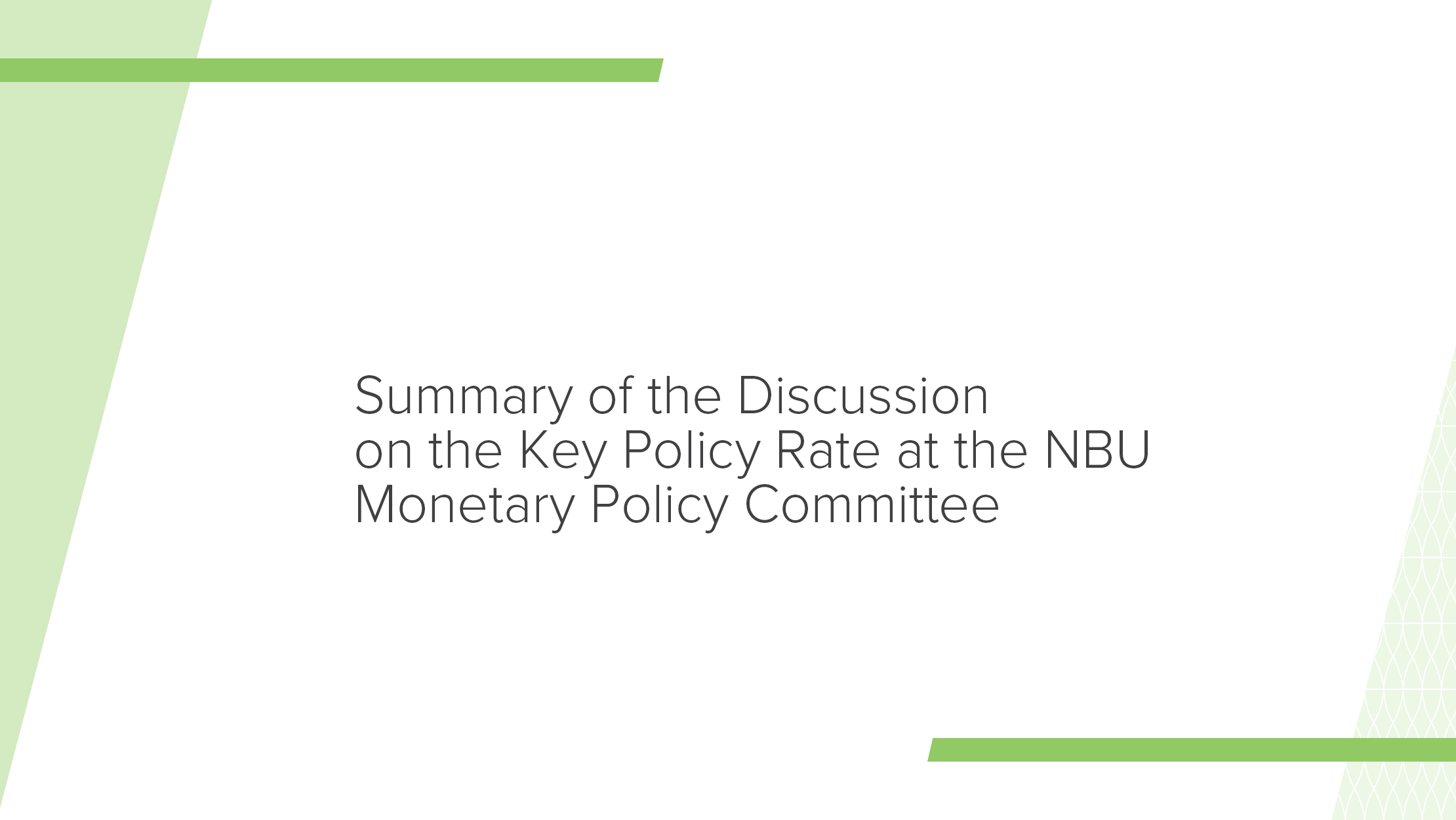Date of the meeting: 22 July 2020.
Attendees: All ten members of the NBU Monetary Policy Committee (MPC):
Kyrylo Shevchenko - NBU Governor
Kateryna Rozhkova - First Deputy Governor
Roman Borysenko - Deputy Governor
Dmytro Sologub - Deputy Governor
Sergii Kholod - Deputy Governor
Oleg Churiy - Deputy Governor
Vitalii Vavryshchuk – Director of the Financial Stability Department
Volodymyr Lepushynskyi - Director of the Monetary Policy and Economic Analysis Department
Yurii Polovniov - Director of the Statistics and Reporting Department
Serhii Ponomarenko - Director of the Open Market Operations Department.
High-frequency indicators have shown that the Ukrainian economy is gradually recovering, the MPC members pointed out during the meeting. Business expectations in trade and industry have almost reached pre-quarantine levels. In June, retail trade continued its gradual recovery, while the decline in consumer imports decelerated. However, in light of elevated uncertainty around how the coronavirus situation is going to unfold, households and businesses are likely to continue to be quite restrained in their consumer and investment decisions, the MPC members agreed. Accordingly, monetary policy must remain stimulating to support economic recovery.
However, the inflationary trend reversed in June, the MPC members noted. Key factors that previously restrained price growth have largely changed their impact to pro-inflationary. As the global economy has gradually recovered, demand for energy has risen, pushing fuel prices higher, which will result in price increases for a significant number of other goods and services in the Ukrainian economy. Disinflationary pressures from subdued consumer demand will also gradually subside as economic activity resumes. As a result, inflation will continue to accelerate, approaching the 5% target in late 2020, and potentially reaching the upper bound of the 5% +/-1 pp target range in 2021.
During the meeting, its participants paid considerable attention to discussing the potential impact of the recently announced increase in social standards on economic growth, unemployment, and inflation. In this regard, they also discussed alternative scenarios of the NBU’s monetary policy response. In 2017, wage increases had a strong impact on inflation, and given the current economic reality, this experience should be taken into account when making future monetary policy decisions, some of the MPC members said. However, a rise in social standards, as well as its impact on wages in the private sector, could be significantly limited, as the economic recovery is only in its initial stage, the labor market is weak, and financial resources of both the public and private sectors are limited, other MPC members pointed out. Accordingly, the impact on inflation will also be moderate. More precisely, the scale and timing of this factor’s impact can be estimated only after the draft law on the state budget for 2021 is passed.
Seven MPC members offered to keep the key policy rate at the 6% level
On the one hand, this will restrain price growth as the economy recovers in 2021–2022. On the other hand, this will leave enough room for further decreases in the cost of debt to a single-digit level.
At the same time, a new cut to the key policy rate in the current environment would create more risks than benefits, according to proponents of keeping the rate unchanged. An additional monetary impulse would have a rather limited potential. The problems that prevent lending from making a full recovery are primarily to be found in the nonmonetary plane. That includes inadequate protection of creditor rights, a sizable shadow economy, and a high level of accumulated nonperforming loans.
Risks to the inflation forecast over the policy horizon have increased from the previous MPC meeting and have been combined with heightened uncertainty, the MPC members said, expressing their concern. In particular, inflation expectations are showing mixed trends and may worsen as depreciation pressures increase. The growth in prices for raw foods (including fruits) may accelerate due to adverse weather conditions. Data on prices for individual services remain imputed and may show unexpected dynamics, going forward. Moreover, the scale and timing of steps to raise living standards may create an additional element of uncertainty. Should the identified risks materialize, the NBU will most likely be forced to switch to a tighter monetary policy to return consumer inflation to the target range. Thus, a temporary reduction in the key policy rate at a time when a rapid increase in the short term is highly likely may give the wrong signal to the market and negatively affect public confidence in the NBU’s monetary policy.
In addition, another cut to the key policy rate may trigger exchange rate pressures and a further dollarization of the economy as the spread between hryvnia and FX deposit rates narrows, several MPC members said.
In the face of deteriorating inflation expectations, a further reduction in the key policy rate would mean that the real key policy rate would enter negative territory, one MPC member noted. Countries with anchored inflation expectations and a high level of confidence in the central bank and the national currency can maintain financial stability while the real key policy rate is negative. In Ukraine, however, a negative real key policy rate would have bad consequences for the economy. In particular, it can be adversely perceived by both domestic economic agents and foreign investors.
For banks, the weighted average cost of hryvnia funding (including the cost of making required reserves and contributions to the Deposit Guarantee Fund) is already higher than the rate on the NBU’s certificates of deposit, meaning a further reduction of the key policy rate would erode the profitability of banks. This may limit the efficiency of monetary transmission or even reverse the dynamics of interest rates. A decline in banks’ profits would also lead to a decrease in their capitalization compared to the potential level. This would pose a threat to financial stability (especially with the share of nonperforming loans gradually rising), and worsen the prospects for increasing lending to support economic recovery.
The term structure of bank funding continues to deteriorate, another MPC member said. The growth in the total funds held by households in the banking system is primarily driven by higher current account balances (including wages and pensions) – not by increases in time deposits. A further reduction of the key policy rate against the backdrop of growing liquidity benefits may exacerbate these negative trends and thus weigh down long-term lending.
However, previous cuts to the key policy rate, which brought it to an all-time low, have yet to be fully reflected in the cost of debt in financial markets, the MPC members emphasized. In particular, banks will need more time to adapt to the new, low-interest-rate environment, and to rethink their strategies. The key policy rate will stay below its neutral level, so even if it remains unchanged, monetary conditions will still be stimulating for a long time. Banks are expected to continue to reduce interest rates on deposits and loans, which will support the economy. This will also be facilitated by the further use of the instruments introduced by the NBU for the development of business lending and mortgages (long-term refinancing and interest rate swaps).
Three MPC members advocated a cut in the key policy rate by 50 bp, to 5.5%
Consumer demand will remain depressed for a long time, they suggested. The recovery in consumer demand that is starting to take shape at this time may be volatile given that a second wave of the pandemic is highly likely.
By cautiously proceeding with lowering the key policy rate in a way that would mean smaller cuts, the NBU will not have a negative impact on inflation expectations, as this policy is in line with market forecasts, one MPC member said. The economy needs more monetary support. Without it, it will be difficult to overcome the negative effects of the crisis, he said.
With regard to the projected trajectory of the key policy rate, the MPC members’ opinions were divided.
Given the balance of risks, the key policy rate is likely to remain at the current level for at least until late 2020, five MPC members said. Two MPC members suggested a possibility of raising the key policy rate as soon as the end of this year. On the other hand, there is room for further potential rate reductions in the short term, three MPC members said.
At the same time, the vast majority of MPC members shared the view that in 2021, the key policy rate would probably have to be raised to counteract mounting inflationary pressures. However, should the recovery in consumer and investment demand begin to slow, the NBU will be able to give the economy an additional boost so that it can recover more quickly, the MPC members agreed.
The decision to keep the key policy rate at 6.0% per annum was approved by the NBU Board at the monetary policy meeting held on 22 July 2020.
The Monetary Policy Committee (MPC) is the NBU’s advisory body created to share information and opinions on monetary policy formulation and implementation in order to deliver price stability. The MPC comprises the NBU Governor, other NBU Board members, and directors of the Monetary Policy and Economic Analysis, Open Market Operations, Financial Stability, and Statistics and Reporting Departments. The MPC meets the day before the NBU Board meeting on monetary policy issues. Decisions on monetary policy issues are made by the NBU Board.


